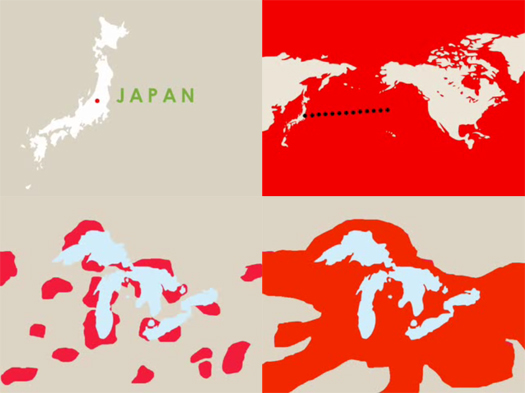
[Mapping the transference of botanical threats from Japan to the Midwest, from a video presentation on Japanese Knotweed (Polygonum cuspidatum) in the Great Lakes region]
From a recent article in the Guardian:
Biological warfare is to be declared on an alien invader, Japanese knotweed, that swamps gardens and rivers, with the release of an insect to eat the virulent weed.
The decision by the Department for Environment, Food and Rural Affairs is the first allowing one non-native species, a flying insect resembling a miniature moth, to control the seemingly unstoppable spread of an alien plant…
The wildlife minister, Huw Irranca-Davies, said the fast-growing Japanese knotweed was estimated to cost £150m a year to control, and was able to grow through buildings and roads.
[Knotweed] has also been blamed for flooding, by causing erosion to river banks and clogging up streams with dead plants.
The decision is not without controversy, though, as some environmentalists worry that introducing an exotic predator — the chosen Aphalara itadori, a “plant jumping lice” — is potentially as disastrous as the original introduction of knotweed. Given the history of predator introduction (in which the introduced predator has occasionally proven more harmful than the prey it was introduced to control), that worry is not wholly absurd, despite assurances from the British government that the introduced insects will be studied in tightly controlled environments before wide release. But it’s probably worth noting that humanity has already spent the past couple centuries engaging in an unprecedented experiment in cross-species conflict at a global scale…
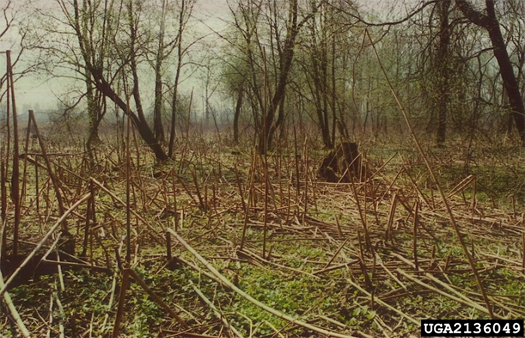
[The aftermath of a knotweed clearning operation; Invasive plant images via Invasive.org]
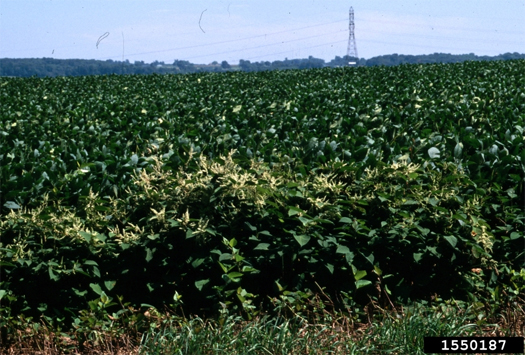
[A Japanese knotweed infestation in Ohio]
I’m reminded of a conversation I had with a horticulturist recently. She noted that, due to the extreme pest pressures North American native species now face, some horticulturists now think that the appropriately far-sighted practice is to only plant invasive species1. This, of course, flies in the face of the prevailing dogmas of landscape and botanical disciplines, where the categories “native” and “invasive” are treated not as functional ecological descriptors, but as moral markers: to cultivate invasive plants is considered ecological violence, while planting and preserving natives is an indication of moral righteousness.
It is, of course, true that there are a number of good reasons to prefer native plants to exotics, and a corresponding number of good reasons to combat the spread of invasive plants, neither of which I have any intention of minimizing.
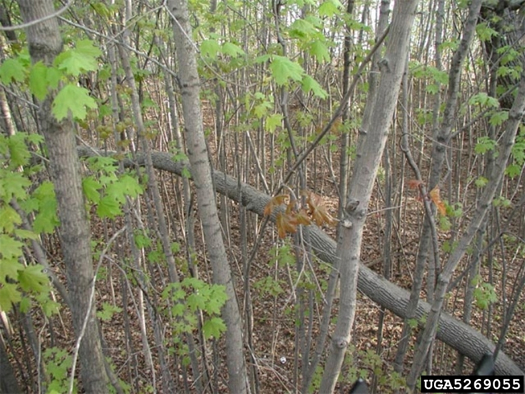
[A future forest of Norway Maple?]
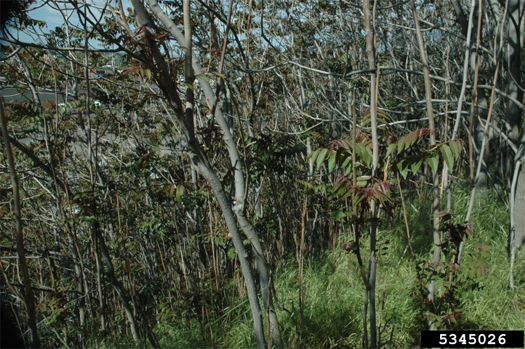
[A future grove of Ailanthus altissima?]
But I’m still haunted (and not at all pleased, despite my fascination) by the thought that the decline of native species might be inevitable. Native species may be adapted to climate and local ecology, but perhaps only invasives are adapted to free trade, and free trade’s attendant equalization of global pest regimes?2 Are the Native Plant Societies destined to be horticultural equivalents of the Institute of Classical Architecture, propagating an aesthetic preference which has certain pleasant associations for many people, but which is no longer derived from any functional process?
Moreover: are these the future forests of the Eastern seaboard? Not Oak-hickory-pine nor Maple-beech-birch, but Mulberry-Ailanthus-Norway Maple? If so, these future forests would have been constructed by the aggregate effect of human economies spread across several centuries, so that we might have even been said to have unintentionally cultivated them with shipments of insect-bearing fruits, the massive growth of the globalized horticultural trade in the nineteenth century, ballast-loads of exotic aquatics, and ornamental gardens which lurked on the edges of our cities like botanical time-bombs (or, perhaps, the unknowing seeds of the preservation of some forest — if not quite our forest — as strange and unnatural as it might be). Free trade as a form of monumental gardening, with the entire biosphere its terra fluxus. Profit-seeking corporations and capitalist nation-states as unwitting gardeners, container ships their trowels.
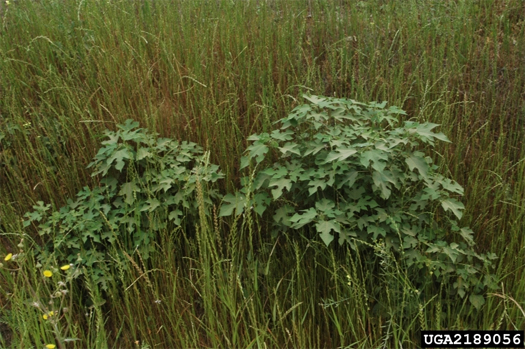
[A small future stand of Paper mulberry?]
And this is to say nothing of more radical but entirely possible futures, such as that bioengineering our crops might, through cross-pollination, produce fields of genetically-enhanced “superweeds”; yet would forests of incredibly adaptable invasive hardwoods and savannahs of superweeds not be preferable to genetically-pure but frail, choking, and dying landscape-museums of natives? At some point, presumably, we would admit the evolutionary superiority of kudzu, a plant which is adapted not just to soils, rainfall, and temperatures, but to us and the disturbances we produce.


Great post Rob.
I was thinking if you expanded the timeframe, perhaps in terms of geologic time, “native” species wouldn’t exist, but all are in a continuous migration transported by the earth’s processes.
Well invasive species are usually so aggressive that they create monocultures, which then collapse due to sudden plagues. It’s an, er, classic tragedy of overreaching and hubris. Then on the long term, there is speciation.
But those at the ICA do have a similar attitude: defensive, and burdened with an unstated assumption that nature is more or less static on the long term. That is clearly not true. Whither the mastodon?
But then we have to consider whether humans are causing the ecological shift. After all, that depends on whether you interpret humans to be part of the ecology or somehow separate. Looking back and forth between the XIIIe (or even the VIIIe) and an emergent slum in Madras, I think that’s an open question.
“….some horticulturists now think that the appropriately far-sighted practice is to only plant invasive species…”
I think its helpful in the native vs. non-native debate to approach it in terms of systemic relationships or ecology–aspects we often can’t physically see, rather than focusing on isolated species. Once aggressive invasives come to dominate an environment, the relational structure of the system typically breaks down, reducing overall complexity and resiliency, and has already been mentioned, often produces monocultures. An Ailanthus forest in North America may look like a forest, but from an ecology point of view its really not because it will not contain the same richness and functional processes.
I can appreciate the logic of a world of weed ecology (humans being the weed par excellence) based on a palette of species perfectly adapted to our ‘disturbance’ mode or operating (which may be turn out to be relatively short and terminal from a broader time frame), but what we lose in this is immense and largely unknowable like climate change – which will further complicate the idea of nativity as biomes have begun to drift around the surface of the globe.
I would argue that the continuation and maintenance of diverse,complex ecologies (rather than aesthetics) is worth fighting for.
the work by the North American Plant Germplasm System is probably of interest to this conversation.
They have a specific mandate to mantain and enlarge the genome, which is critical especially for agricultural production (creating hybrids that combat diseases or pests or draught). it’s an everyday practical extention of the doomsday vault up in Norway.
there was recently an article in wired about how this system is being used to combat ugandan wheat rust which could potentially threaten the entire world supply potentially. also, npr “on point with tom ashbrook” recently interviewed a lady who gave a great rundown of the workings of it and argued that it is woefully underfunded and unloved for the critical function it provides.
i would agree with f.a.d’s last sentence wholeheartedly. if you frame the argument in terms of native v. non-native then you end up in a philosophical/semantic debate. but if it’s about maintaining or even enriching biodiversity (and eo wilson would say that is critical) then i think the argument is a lot clearer and the question becomes what strategies and tactics to implement.
as an aside, i dig ailanthus. also, mammoth is sounding a lot more bldgblog-esque after that glacier/island/storm week…
Predictably, you’ll find no disagreement here about the value of aiming for “diverse and complex ecologies” (and I couldn’t agree more that “forest” is best defined ecologically, i.e. on the basis of the processes occurring, not aesthetically; just because it has trees doesn’t mean that its a forest), though I don’t mean to sound as though I think there’s no value in the psychological or cultural qualities of nativity (I’m pretty sure that’s not a word, but I think it works there). Whether notionally invasive species can be a part of such ecologies is probably a trickier question, but there’s no question that (as the images in the post illustrate) their tendency is often towards, as цarьchitect and F.A.D. note, monoculture.
What this horticulturist said to me did surprise me, though, in that she suggested that horticulturists are so concerned about the pest pressures on native tree species that they are not certain that there is a long-term future for native trees. Whether that’s somewhat hyperbolic or not, I can’t tell you, and I’m not about to run out and start planting Ailanthus whips in beech groves “to prepare the planet for the future”, but, as I said above, I’m really haunted by this idea, because, if its true, then one part of a strategy for diversity and complexity might necessarily be figuring out how to nudge invasives away from monoculture and towards ecological productivity. Though, even if that’s not hyperbole — if native forests are doomed — that’s no reason not to do what we can to buttress them.
Of course, you might take another thing that she said to me (about an increasing interest in planting North American natives on the part of horticulturists elsewhere), and stretching this in an even more implausible direction, wonder if our native forests won’t end up in, say, Europe, while we end up with Sino-Japanese forests. There’s probably no way that happens without being a complete ecological catastrophe, but that’s what we all think we’re headed for anyways, right?
[…] 3) Mammoth on the future forests of the Eastern Seaboard. […]
[…] if the seedbombs contained the seeds of the future forests of an infrastructural seaboard? This entry was written by rholmes, posted on May 6, 2010 at 10:56 pm, filed under futures, […]
[…] and valuation of “crypto-forests”, “cosmopolitan” plant communities, and invasive species. Techentin says: “Wild nature, or what may be left of it, seems all but removed from […]